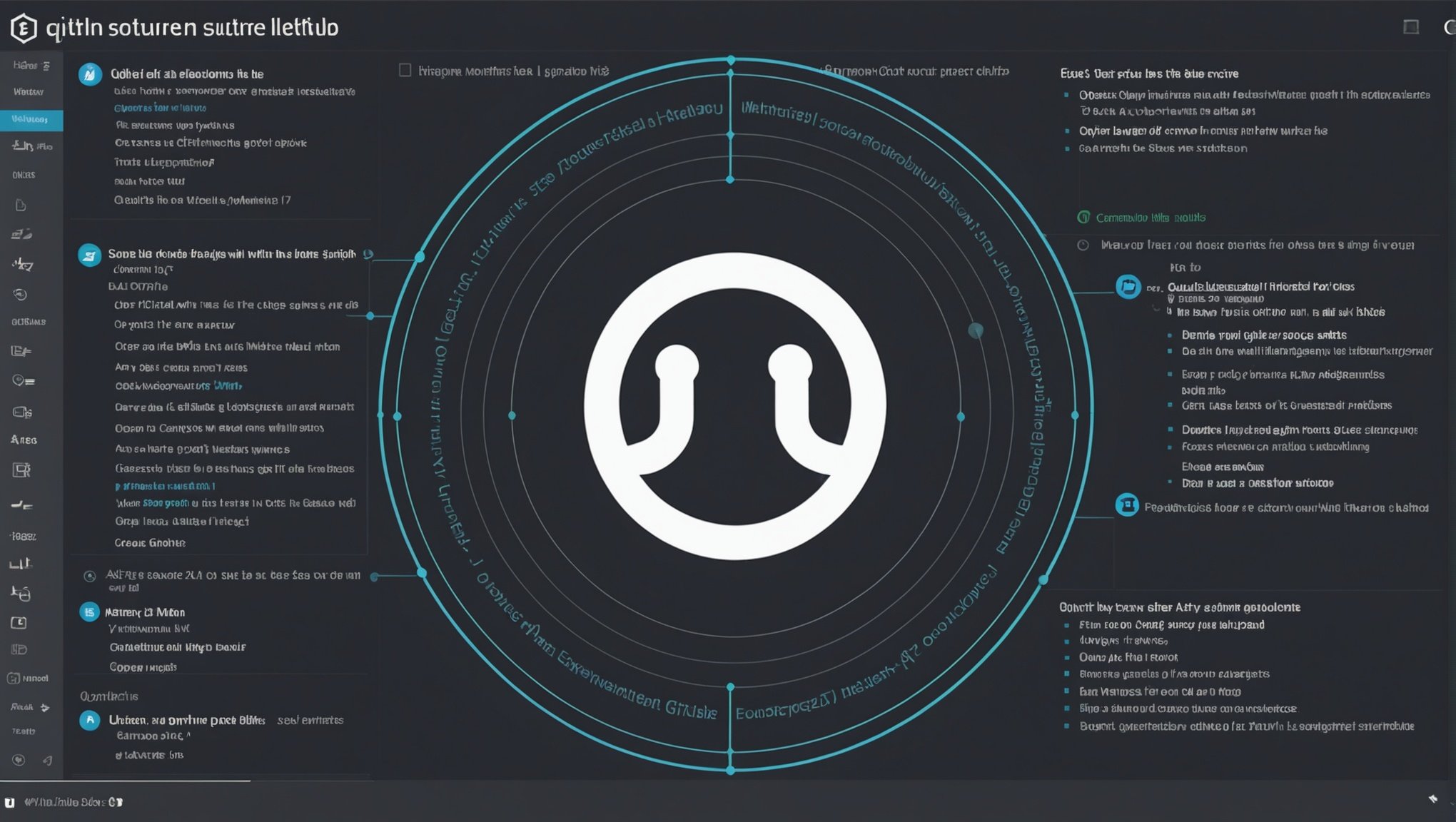GitHub has transformed the landscape of software development, particularly for open-source projects. This platform enables developers from around the world to collaborate, share, and improve code, fostering a community-driven approach to software creation. Navigating this robust ecosystem effectively requires adherence to certain best practices. In this article, we delve into the essential guidelines to follow when using GitHub for your open-source projects.
Setting Up Your Repository
The foundation of any successful open-source project on GitHub is a well-structured repository. This initial setup phase is crucial and lays the groundwork for how contributors will interact with your project.
In parallel : What are the methods to implement data validation in a Django REST framework?
First and foremost, choose a descriptive repository name that clearly conveys the project’s purpose. This helps in attracting contributors who might be searching for specific projects or functionalities. Alongside the name, an informative and concise README file is indispensable. This file serves as the project’s homepage, summarizing its goals, features, installation instructions, and usage examples. Well-crafted README files not only provide necessary information but also showcase the project’s professionalism.
Another critical aspect is the creation of a LICENSE file. This document specifies how others can use, modify, and distribute your project. Choosing an appropriate open-source license ensures legal clarity and fosters trust among contributors. Popular choices include MIT, Apache 2.0, and GPL, each with distinct permissions and restrictions.
Also read : How do you implement OAuth 2.0 in a Spring Boot application for client credentials flow?
In addition, setting up a clear contribution guide is essential. This guide outlines how potential contributors can get involved, the coding standards they should follow, and how to submit pull requests. An organized and welcoming contribution guide can significantly enhance the collaborative aspect of your project, encouraging more developers to participate.
Lastly, consider implementing a code of conduct. This document sets the tone for interactions within the project, promoting respectful and constructive communication. A positive and inclusive environment can attract a diverse group of contributors, enriching the project’s development.
By focusing on these foundational elements during the repository setup phase, you create a solid platform that facilitates effective collaboration and sets the stage for a thriving open-source project.
Managing Documentation Effectively
Effective documentation is the backbone of any thriving open-source project. It ensures that both new and experienced contributors can understand, use, and improve your project efficiently.
A README file, while essential, is just the beginning. Comprehensive documentation should include detailed guides on installation, usage, and troubleshooting. Installation guides should cater to various operating systems and environments, ensuring that users can set up the project without hurdles. Usage guides should provide step-by-step instructions and examples to demonstrate the project’s capabilities. This helps users quickly grasp the project’s functionalities and apply them to their needs.
Beyond these basics, consider creating an API reference if your project includes a programmable interface. This reference should cover all available functions, parameters, and return values in detail, providing clear examples for each. Such thorough documentation not only aids developers in using the API correctly but also minimizes the need for repeated support queries.
Another vital aspect is maintaining an FAQ section. Common questions and issues can be addressed here, providing quick solutions and reducing the burden on maintainers to answer repetitive queries. This section should be regularly updated based on user feedback and emerging issues.
Additionally, leveraging automated documentation tools can streamline the documentation process. Tools like Javadoc for Java or Sphinx for Python can generate documentation directly from your codebase, ensuring consistency and saving time. Regularly updating your documentation to reflect changes in the codebase is crucial for maintaining its relevance and accuracy.
Finally, consider the user experience of your documentation. A well-organized, searchable, and easy-to-navigate documentation site can significantly enhance usability. Tools like Read the Docs or GitHub Pages can help create visually appealing and user-friendly documentation websites.
By prioritizing comprehensive and user-friendly documentation, you not only support current users and contributors but also attract new ones, fostering a vibrant and active community around your open-source project.
Implementing Robust Version Control
Effective version control is a cornerstone of any open-source project, ensuring that changes are tracked, managed, and integrated smoothly. GitHub’s version control system provides powerful tools to manage your project’s evolution, but using these tools effectively requires a strategic approach.
Branching strategies play a crucial role in maintaining a clean and organized codebase. Adopting a branching model like Git Flow or GitHub Flow can streamline development and collaboration. For example, GitHub Flow emphasizes a lightweight, branch-based workflow where changes are made in feature branches, reviewed through pull requests, and merged into the main branch upon approval. This approach ensures that the main branch remains stable and production-ready.
Regularly creating releases and tags is another best practice. Releases mark significant milestones in your project’s development, providing users with stable versions to use and refer to. Tags, on the other hand, can be used to label specific commits, making it easy to track and reference important points in the project’s history.
Commit messages should be clear, concise, and informative. A well-written commit message briefly describes the changes made and their purpose, making it easier for collaborators to understand the project’s evolution. Following a consistent commit message format, such as specifying the type of change (e.g., fix, feature, docs) and a short description, can enhance clarity and facilitate better collaboration.
Code reviews are essential for maintaining code quality and consistency. Using pull requests for code reviews allows contributors to propose changes, which can then be discussed, tested, and refined before merging. This collaborative process not only improves the quality of the code but also fosters knowledge sharing and skill development among contributors.
Automating tests and continuous integration (CI) processes can further enhance your version control practices. Tools like GitHub Actions, Travis CI, or CircleCI can automatically run tests and checks on proposed changes, ensuring that new code doesn’t introduce bugs or regressions. This automation helps maintain a high standard of code quality and reliability.
By implementing robust version control practices, you can ensure that your open-source project remains organized, efficient, and scalable, fostering a collaborative and productive development environment.
Encouraging Community Engagement
The strength of an open-source project lies in its community. Engaging and nurturing this community is key to the project’s success and longevity. Building a welcoming and inclusive environment where contributors feel valued and motivated can significantly enhance your project’s development and reach.
One of the first steps in encouraging community engagement is actively communicating with contributors. Promptly responding to issues, pull requests, and questions demonstrates that the project is well-maintained and that contributions are appreciated. Regular updates on the project’s progress, upcoming features, and development goals can also keep the community informed and engaged.
Recognizing and acknowledging contributions is vital. Acknowledging contributors in your documentation, release notes, or a CONTRIBUTORS file can foster a sense of belonging and appreciation. Highlighting significant contributions in project updates or social media can also motivate others to participate.
Creating opportunities for collaboration and discussion is another effective strategy. Hosting regular community meetings, either virtually or in person, can facilitate direct interaction between maintainers and contributors. Platforms like GitHub Discussions or Discord can provide spaces for ongoing conversations, brainstorming, and feedback.
Implementing a mentorship program can also be highly beneficial. Pairing experienced contributors with newcomers can accelerate the onboarding process, providing guidance and support to new members. This not only helps new contributors get up to speed but also strengthens the overall community by fostering relationships and knowledge sharing.
Organizing events and hackathons can further boost community engagement. These events provide focused opportunities for collaboration, learning, and contribution. They can also attract new contributors and increase the project’s visibility within the broader open-source community.
Ensuring that your project is inclusive and accessible is crucial. Adopting inclusive language, providing clear documentation, and designing for accessibility can make your project more welcoming to a diverse range of contributors. A diverse community brings varied perspectives and skills, enriching the project’s development and innovation.
By prioritizing community engagement, you can build a vibrant and supportive ecosystem around your open-source project, driving its growth and success.
Maintaining Security Best Practices
Security is a critical aspect of any open-source project. As your project grows and attracts more users and contributors, ensuring that it remains secure becomes increasingly important. Adopting security best practices can protect your project from vulnerabilities and build trust within your community.
One of the fundamental steps in maintaining security is regularly updating dependencies. Using outdated libraries or frameworks can introduce known vulnerabilities into your project. Tools like Dependabot can automatically monitor your dependencies and create pull requests to update them, ensuring that you stay on top of security patches.
Implementing automated security scanning can further bolster your project’s security. GitHub offers built-in security features like the Security Advisory and Dependabot alerts, which can help identify and mitigate potential vulnerabilities in your codebase. Regularly reviewing and addressing these alerts can prevent security issues from escalating.
Code reviews are not only beneficial for code quality but also for security. Conducting thorough reviews of code changes can help identify and address potential security risks before they are merged. Encouraging contributors to follow secure coding practices and providing guidelines on common security pitfalls can also enhance the overall security of your project.
Another important practice is to manage sensitive information properly. Avoid storing sensitive data, such as API keys or passwords, directly in your code repository. Instead, use environment variables or secure secret management tools to handle such information. GitHub Secrets can help securely store and manage sensitive information for use in your CI workflows.
Adopting a responsible disclosure policy can also be beneficial. This policy outlines how security researchers and users can report vulnerabilities they discover in your project. Being responsive to these reports and addressing them promptly demonstrates a commitment to security and builds trust with your users and contributors.
Regularly auditing your codebase for security vulnerabilities is another crucial step. Conducting periodic security audits, whether internally or through external security experts, can help identify hidden vulnerabilities and areas for improvement.
By incorporating these security best practices, you can protect your open-source project from potential threats, ensuring its integrity and maintaining the trust of your community.
In conclusion, following best practices when using GitHub for open-source projects is essential for creating a successful and sustainable project. From setting up a well-structured repository, managing documentation effectively, and implementing robust version control, to encouraging community engagement and maintaining security best practices, each aspect plays a crucial role in the project’s development and success.
By adhering to these guidelines, you can create an open-source project that attracts contributors, fosters collaboration, and thrives within the open-source community. Ultimately, the success of your project hinges on the dedication and collaboration of its contributors, and by following these best practices, you can create an environment that supports and nurtures their efforts.











